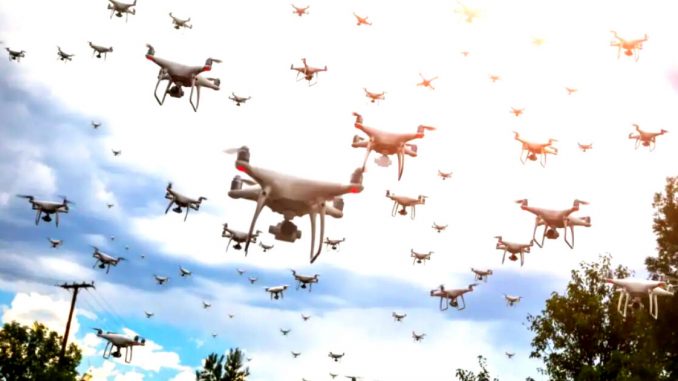
A psyop could be blurring the limits between empty reports and hostile action
Published November 10, 2025
A Surge in Drone Activity
In early November 2025, Belgium faced a series of alarming drone incursions over critical infrastructure, raising concerns across Europe. Brussels Airport and Liège Airport were forced to temporarily suspend operations after multiple unidentified drones were detected in their airspace. Security authorities reported that the drones were also observed near several military installations, including one facility believed to house U.S. nuclear weapons. The flights, detected during both daytime and nighttime hours, caused significant disruption to air traffic and heightened security vigilance.
Belgium’s Defence Minister, Theo Francken, noted that the operations appeared sophisticated and unlikely to have been conducted by amateurs, suggesting possible intelligence-gathering or surveillance objectives.
Regional Patterns
The incidents in Belgium are not isolated. Several other European countries—including Germany, Denmark, Norway, and Sweden—have reported similar drone activity over airports and sensitive facilities in recent months. German authorities confirmed repeated sightings of drones over restricted areas, triggering temporary halts to airport operations and increased military readiness.
The patterns of flight—including altitude, time of day, and proximity to sensitive installations—suggest a deliberate approach rather than isolated or accidental flights. Some observers described the drones’ flight patterns as methodical, circling key infrastructure and military zones, sometimes loitering for extended periods.
Allied Response
Belgium promptly requested assistance from regional allies, leading to a coordinated European response:
-
United Kingdom: The UK dispatched a specialist anti-drone team along with technical equipment to Belgium. Air Chief Marshal Richard Knighton confirmed that the team would assist Belgian authorities in identifying, tracking, and neutralizing unauthorized drones over sensitive sites.
-
France: French authorities sent counter-drone resources, including mobile detection units, to reinforce Belgian airspace security.
-
Germany: German defense forces also deployed anti-drone equipment and personnel to assist Belgian authorities.
The coordinated response reflects a recognition that the drone activity was not merely a local security issue but a broader European concern, prompting allied nations to combine technical expertise and personnel.
Operational Details
Authorities in Belgium reported that multiple drones were detected flying at various altitudes, some approaching restricted airspace near military installations. Surveillance footage and radar tracking revealed that the drones were operating independently of commercial flight paths, with no visible operators on the ground. Officials highlighted the potential for these devices to carry sensors capable of gathering intelligence or conducting reconnaissance over critical infrastructure.
Belgian authorities temporarily restricted airspace in affected areas, diverting commercial flights and reinforcing perimeter security around military bases. In some instances, military personnel used radar and visual monitoring to track drone movements, though interception attempts were limited due to legal restrictions surrounding civilian airspace operations.
Technical and Tactical Aspects
According to defence analysts, the drones observed in Belgium were small, unmanned aerial vehicles, likely equipped with high-resolution cameras and navigation systems. While no drone carried weapons or posed immediate kinetic threats, the flights demonstrated precision and persistence, circling sensitive areas multiple times over several hours.
Belgian security teams are employing layered detection methods, including radar tracking, radio frequency monitoring, and visual observation. The UK and France have contributed counter-UAV technologies, including mobile jamming units and directed-energy detection systems, to assist in tracking and neutralizing unauthorized drones. This collaborative deployment allows rapid identification of incursions and improved response times.
Government Statements
Belgian officials have consistently emphasized public safety and transparency. Defence Minister Theo Francken stated that while no immediate threat to civilians was detected, the presence of drones over airports and military facilities necessitated swift action. Airport authorities implemented temporary flight suspensions as a precautionary measure, prioritizing the safety of passengers and personnel.
European Union representatives have closely monitored the incidents, stressing the importance of allied cooperation in addressing emerging aerial threats. NATO officials have also expressed interest in integrating lessons learned from the Belgium incidents into broader alliance-wide protocols for counter-drone operations.
Media and Public Attention
The drone activity has garnered significant attention from both national and international media. Reports describe a combination of civilian disruption and military sensitivity, highlighting the complexities of modern airspace security. Public commentary has varied, with some outlets framing the incidents as a test of European airspace defenses, while others have raised concerns about potential espionage or intelligence-gathering objectives.
Social media footage captured by civilians near affected airports has circulated widely, showing small unmanned aerial vehicles hovering over restricted areas. These images have contributed to public awareness and discussion regarding the growing prevalence of drones in security-sensitive environments.
Security Coordination
Belgium has activated a national coordination center, linking airport authorities, military units, and police to monitor drone activity in real-time. Allied teams from the UK, France, and Germany have integrated into these operations, bringing technical expertise and equipment to enhance detection and mitigation efforts.
Air traffic controllers in Brussels and Liège have worked closely with military personnel to reroute flights and minimize disruptions, while ensuring that commercial air traffic continues with minimal impact. Security briefings for personnel at military bases have been intensified, emphasizing vigilance and reporting of unauthorized aerial activity.
Timeline of Events
-
Early November 2025: Initial drone sightings reported at Brussels and Liège airports; temporary flight suspensions enacted.
-
Following days: Drones observed near military installations; Belgian authorities request allied assistance.
-
UK Deployment: Specialist anti-drone team sent to Belgium with technical equipment and personnel.
-
France & Germany Deployment: Counter-drone resources dispatched to reinforce Belgian security measures.
-
Ongoing: Collaborative operations continue, with radar monitoring, aerial surveillance, and coordination across allied nations.
 Implications
Implications
Security Implications
-
Critical Infrastructure Vulnerability
-
Airports and military bases—normally considered secure—are now vulnerable to low-cost, small drones.
-
Even unarmed drones can disrupt flights, gather intelligence, or test security systems, forcing countries to rethink perimeter defenses and airspace monitoring.
-
-
Hybrid Threat Awareness
-
These incidents illustrate the growing hybrid threat environment, where low-risk, ambiguous operations can have high impact.
-
Such drone flights blur the line between espionage, sabotage, and psychological operations, making attribution and response more difficult.
-
-
Force Readiness and Coordination
-
The rapid deployment of UK, France, and Germany counter-drone teams highlights the need for allied coordination.
-
Shows that local authorities alone may not be equipped to counter technologically sophisticated UAV threats.
-
Legal and Regulatory Implications
-
Airspace Management Challenges
-
Existing laws may limit the ability of authorities to shoot down or jam drones over civilian areas, complicating defensive measures.
-
Updates to aviation and counter-UAV legislation may be required to protect critical infrastructure.
-
-
Civil-Military Coordination
-
Incursions over airports force authorities to balance civil aviation safety with national security needs.
-
Establishing clear legal protocols for interception and neutralization is critical.
-
Technological and Defense Implications
-
Counter-Drone Technology Demand
-
Detection systems, jammers, and interception drones are likely to see increased deployment in Europe.
-
Governments may invest in integrated “drone walls” around sensitive sites.
-
-
Intelligence and Surveillance Capabilities
-
Drones can collect imagery, signals, and movement patterns from sensitive sites.
-
This may accelerate surveillance countermeasures and intelligence-sharing between allies.
-
Geopolitical Implications
-
Alliance Solidarity
-
The coordinated response strengthens NATO and EU cohesion, showing that members are willing to assist each other during security incidents.
-
Demonstrates the importance of multinational rapid response capabilities for hybrid threats.
-
-
Potential State-Sponsored Operations
-
While attribution remains unconfirmed, the sophistication and targeting patterns suggest potential involvement of state actors or proxies.
-
Raises the stakes in European security, signaling that drones can serve as strategic instruments in geopolitical maneuvering.
-
Economic Implications
-
Financial Costs
-
Airport shutdowns, increased security measures, and deployment of specialized counter-drone units come with significant costs.
-
Insurance and operational expenses for commercial aviation could rise if drone threats persist.
-
-
Defense Procurement and Industry Growth
-
Increased demand for UAV detection and countermeasures may drive defense procurement spending, benefiting security technology firms.
-
 Overall Takeaway:
Overall Takeaway:
The recent wave of unidentified drone incursions over Belgium underscores the evolving nature of security threats in Europe. From airports to military bases, even critical infrastructure once considered secure is now vulnerable to low-cost, technologically capable drones. The rapid response by the United Kingdom, France, and Germany highlights the importance of allied coordination and readiness in addressing these challenges.
As authorities continue to monitor and counter these aerial intrusions, the events serve as a reminder that modern security requires a combination of technology, intelligence, legal frameworks, and international cooperation. The Belgium incidents illustrate that in an era of hybrid threats, vigilance and adaptability remain essential to safeguarding both civilian and military assets.
SOURCES: THE GATEWAY PUNDIT – UAV PANIC: A PSYOP? Unidentified Drones Over Belgium Lead to UK, France and Germany Sending Troops and Equipment to Counter the ‘Threat’
EURONEWS – UK deploys anti-drone specialists to Belgium after string of incursions
POLITICO – Britain, France and Germany deploy anti-drone teams to Belgium





Be the first to comment